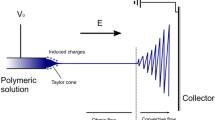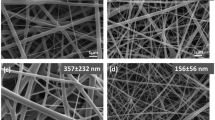Abstract
The aim of this study was to synthesize dual-functionalized poly(vinyl alcohol) (PVA)/poly(acrylic acid) (PAA) electrospun nanofibers with enzyme and copper ion (Cu(II)) for enhancing anti-biofouling activities. The PVA/PAA nanofibers were successfully synthesized by co-electrospinning (voltage = 17 kV; tip-to-collector distance = 15 cm) and cross-linked by heat treatment. The PVA/PAA nanofibers were functionalized through adsorbing Cu(II) onto the nanofibers to prepare the PVA/PAA-Cu(II) nanofibers. Three proteases (proteinase K, trypsin, and α-chymotrypsin) and a quorum quenching enzyme (acylase I) were tested for biofilm reduction that α-chymotrypsin effectively inhibited the biofilm formation and removed biofilms of Pseudomonas aeruginosa and Staphylococcus aureus. The PVA/PAA nanofibers were dual-functionalized with α-chymotrypsin and Cu(II) to obtain PVA/PAA-Cu(II)-α nanofibers. Degradation tests for extracellular polymeric substances (EPS) extracted from P. aeruginosa indicated that the PVA/PAA-Cu(II)-α nanofibers could degrade the EPS proteins up to 0.26 mg mL−1 for 300 min, which was higher than that of free α-chymotrypsin. For anti-biofouling tests, the log number of planktonic and sessile cells of P. aeruginosa was the lowest in the PVA/PAA-Cu(II)-α nanofibers. The anti-biofouling activities of the PVA/PAA-Cu(II)-α nanofibers could be attributed to the effects of both Cu(II) (killing planktonic and sessile cells) and α-chymotrypsin (degrading the EPS protein in biofilm).









Similar content being viewed by others
References
Cloete TE, de Kwaadsteniet M, Botes M, Lopez-Romero JM, Hierrezuelo-Leon J, Cakmakci M, Koyuncu I, Garrido-Perez E (2010) Nanotechnology in water treatment applications. Caister Academic Press, Norfolk
Zhu J, Hou J, Zhang Y, Tian M, He T, Liu J, Chen V (2018) Polymeric antimicrobial membranes enabled by nanomaterials for water treatment. J Membr Sci 550:173–197
Davis D (2003) Understanding biofilm resistance to antibacterial agents. Nat Rev Drug Discov 2:114–122
Stewart PS, McFeters GA, Huang CT (2000) Biofilm control by antimicrobial agents. In: Bryers JD (ed) Biofilms II: process analysis and application. Wiley, New York
Donlan RM, Costerton JW (2002) Biofilms, survival mechanisms of clinically relevant microorganisms. Clin Microbiol Rev 15:167–193
Molobela P, Cloete TE, Beukes M (2010) Protease and amylase enzymes for biofilm removal and degradation of extracellular polymeric substances (EPS) produced by Pseudomonas fluorescens bacteria. Afr J Microbiol Res 4:1515–1524
Olsen SM, Pedersen LT, Laursen MH, Kill S, Dam-Johansen K (2007) Enzyme-based antifouling coatings, a review. Biofouling 23:369–383
Leroy C, Delbarre C, Ghillebaert F, Compere C, Combes D (2008) Effects of commercial enzymes on the adhesion of a marine biofilm-forming bacterium. Biofouling 24:11–22
Zanoni M, Habimana O, Amadio J, Casey E (2016) Antifouling activity of enzyme-functionalized silica nanobeads. Biotechnol Bioeng 113:501–512
Meshram P, Dave R, Joshi H, Dharani G, Kirubagaran R, Venugopalan VP (2016) A fence that eats the weed: alginate lyase immobilization on ultrafiltration membrane for fouling mitigation and flux recovery. Chemosphere 165:144–151
Kristensen JB, Meyer RL, Laursen BS, Shipovskov S, Besenbacher F, Poulsen CH (2008) Antifouling enzymes and the biochemistry of marine settlement. Biotechnol Adv 26:471–481
Xavier JB, Picioreanu C, Rani SA, van Loosdrecht MCM, Stewart PS (2005) Biofilm control strategies based on enzymatic disruption of the extracellular polymeric substance matrix- a modeling study. Microbiology 51:3817–3832
Kim JH, Choi DC, Yeon KM, Kim SR, Lee CH (2011) Enzyme-immobilized nanofiltration membrane to mitigate biofouling based on quorum quenching. Environ Sci Technol 45:1601–1607
Du Plessis DM, Botes M, Dicks LMT, Cloete TE (2012) Immobilization of commercial hydrolytic enzymes on poly(acrylonitrile) nanofibers for anti-biofilm activity. J Chem Technol Biotechnol 88:585–593
Kim LH, Kim SJ, Kim CM, Shin MS, Kook SH, Kim IS (2013) Effects of enzymatic treatment on the reduction of extracellular polymeric substances (EPS) from biofouled membranes. Desalin Water Treat 51:6355–6361
Brady D, Jordaan J (2009) Advances in enzyme immobilization. Biotechnol Lett 31:1639–1650
Wang ZG, Wan LS, Liu ZM, Huang XJ, Xu ZK (2009) Enzyme immobilization on electrospun polymer nanofibers, an overview. J Mol Catal B Enzym 56:189–195
Lee J, Lee I, Nam J, Hwang DS, Yeon KM, Kim J (2017) Immobilization and stabilization of acylase on carboxylated polyaniline nanofibers for highly effective antifouling application via quorum quenching. ACS Appl Mater Interfaces 9:15424–15432
Taheran M, Naghdi M, Brar SK, Knystautas EJ, Verma M, Surampalli RY (2017) Degradation of chlortetracycline using immobilized laccase on polyacrylonitrile-biochar composite nanofibrous membrane. Sci Total Environ 605:315–321
Sheldon RA (2007) Enzyme immobilization, the quest for optimum performance. Adv Synth Catal 349:1289–1307
Srbová J, Slováková M, Křípalová Z, Žárská M, Špačková M, Stránská D, Bílková Z (2016) Covalent biofunctionalization of chitosan nanofibers with trypsin for high enzyme stability. React Funct Polym 104:38–44
Santo CE, Lam EW, Elowsky CG, Quaranta D, Domaille DW, Chang CJ, Grass G (2011) Bacterial killing by dry metallic copper surfaces. Appl Environ Microb 77:794–802
Thurman RB, Gerba CP, Bitton G (1989) The molecular mechanisms of copper and silver ion disinfection of bacteria and viruses. Crit Rev Environ Sci Technol 18:295–315
Vincent M, Duval RE, Hartmann P, Engels-Deutsch M (2017) Contact killing and antimicrobial properties of copper. J Appl Microbiol 124:1032–1046
Feng Q, Zhao Y, Wei AF, Li CL, Wei QF, Fong H (2014) Immobilization of catalase on electrospun PVA/PA6-Cu(II) nanofibrous membrane for the development of efficient and reusable enzyme membrane reactor. Environ Sci Technol 48:10390–10397
Lopez-Gallego F, Bentancor L, Mateo C, Hidalgo A, Alonso-Morales N, Della-Ortiz G (2005) Enzyme stabilization by glutaraldehyde crosslinking of adsorbed proteins on aminated supports. J Biotechnol 119:70–75
Park JA, Kang JK, Lee SC, Kim SB (2017) Electrospun poly(acrylic acid)/poly(vinyl alcohol) nanofibrous adsorbents for Cu(II) removal from industrial plating wastewater. RSC Adv 7:18075–18084
Xiao SL, Shen MW, Hui M, Guo R, Zhu MF, Wang SY, Shi XY (2010) Fabrication of water-stable electrospun polyacrylic acid-based nanofibrous mats for removal of copper (II) ions in aqueous solution. J Appl Polym Sci 116:2409–2417
Pitt B, Hamilton MA, Zelver N, Stewart PS (2003) A microtiter-plate screening method for biofilm disinfection and removal. J Microbiol Methods 54:269–276
Zmantar T, Kouidhi B, Miladi H, Mahdouani K, Bakhrouf A (2010) A microtiter plate assay for Staphylococcus aureus biofilm quantification at various pH levels and hydrogen peroxide supplementation. New Microbiol 33:137–145
O’Toole GA, Pratt LA, Watnick PI, Newman DK, Weaver VB, Kolter R (1999) Genetic approaches to study of biofilms. Academic Press San Diego, California
Rachid S, Ohlsen K, Wallner U, Hacker J, Hecker M, Ziebuhr W (2000) Alternative transcription factor σB is involved in regulation of biofilm expression in a Staphylococcus aureus mucosal isolate. J Bacteriol 182:6824–6826
Bradford MM (1976) A rapid and sensitive method for the quantitation of microgram quantities of protein utilizing the principle of protein-dye binding. Anal Biochem 72:248–254
Wang ZG, Ke BB, Xu ZK (2007) Covalent immobilization of redox enzyme on electrospun nonwoven poly(acrylonitrile-co-acrylic acid) nanofiber mesh filled with carbon nanotubes, a comprehensive study. Biotechnol Bioengin 97:708–720
Wingender J, Strathmann M, Rode A, Leis A, Flemming HC (2001) Isolation and biochemical characterization of extracellular polymeric substances from Pseudomonas aerugionosa. Methods Enzymol 336:302–314
Dreywood R (1946) Qualitative test for carbohydrate material. Ind Eng Chem Anal Ed 18:499
de Prijck K, Nelis H, Coenye T (2007) Efficacy of silver-releasing rubber for the prevention of Pseudomonas aeruginosa biofilm formation in water. Biofouling 23:405–411
Zodrow K, Brunet L, Mahendra S, Li D, Zhang A, Li QL, Alvarez PJJ (2009) Polysulfone ultrafiltration membranes impregnated with silver nanoparticles show improved biofouling resistance and virus removal. Water Res 43:715–723
Chen CI, Ko YM, Shieh CJ, Liu YC (2011) Direct penicillin G acylase immobilization by using the self-prepared immobilized metal affinity membrane. J Membr Sci 380:34–40
Sun LM, Zhang CL, Li P (2011) Characterization, antimicrobial activity, and mechanism of a high-performance (-)-epigallocatechin-3-gallate(EGCG)-CuII/polyvinyl alcohol(PVA) nanofibrous membrane. J Agric Food Chem 59:5087–5092
Gule NP, de Kwaadsteniet M, Cloete TE, Klumperman B (2012) Electrospun poly(vinyl alcohol) nanofibers with biocidal additives for application in filter media, 1-Properties affecting fibre morphology and characterization. Macromol Mater Eng 297:609–617
Abbasizadeh S, Keshtkar AR, Mousavian MA (2013) Preparation of a novel electrospun polyvinyl alcohol/titanium oxide nanofiber adsorbent modified with mercapto groups for uranium(VI) and thorium(IV) removal from aqueous solution. Chem Eng J 220:161–171
Sui XM, Shao CL, Liu YC (2005) White-light emission of polyvinyl alcohol/ZnO hybrid nanofibers prepared by electrospinning. Appl Phys Lett 87:113–115
Li W, Li XY, Chen Y, Li XX, Deng HB, Wang T, Huang R, Fan G (2013) Poly(vinyl alcohol)/sodium alginate/layered silicate based nanofibrous mats for bacterial inhibition. Carbohydr Polym 92:2232–2238
Siriwatcharapiboon W, Tinnarat N, Supaphol P (2013) Preparation and characterization of electrospun poly(vinyl alcohol) nanofibers containing platinum or platinum-ruthenium nanoparticles. J Polym Res 20:1–8
Kim DS, Park HB, Rhim JW, Lee YM (2005) Proton conductivity and methanol transport behavior of cross-linked PVA/PAA/dilica hybrid membranes. Solid State Ion 176:117–126
Atymur A, Uslu I (2014) Promising materials for wound dressing, PVA/PAA/PVP electrospun nanofibers. Polym Plast Technol Eng 56:655–660
Pallares I, Vendrell J, Aviles FX, Ventura S (2004) Amyloid fibril formation by a partially structured intermediate state of α-chymotrypsin. J Mol Biol 342:321–331
Hong J, Xu DM, Gong PJ, Sun HW, Dong L, Yao SD (2007) Covalent binding of α-chymotrypsin on the magnetic nanogels covered by amino groups. J Mol Catal B-Enzym 45:84–90
Pendashteh A, Mousavi MF, Rahmanifar MS (2013) Fabrication of anchored copper oxide nanoparticles on graphene oxide nanosheets via an electrostatic coprecipitation and its application as supercapacitor. Electrochim Acta 88:347–357
Yeon KM, Lee CH, Kim JB (2009) Magnetic enzyme carrier for effective biofouling control in the membrane bioreactor based on enzymatic quorum quenching. Environ Sci Technol 43:7403–7409
Aykin E, Omuzbuken B, Kacar A (2019) Microfouling bacteria and the use of enzymes in eco-friendly antifouling technology. J Coat Technol Res. https://doi.org/10.1007/s11998-018-00161-7
Quirόs J, Borges JP, Boltes K, Rodea-Palomares I, Rodal R (2015) Antimicrobial electrospun silver-, copper- and zinc-doped polyvinylpyrrolidone nanofibers. J Hazard Mater 299:298–305
Acknowledgements
This work was supported by the National Research Foundation of Korea, funded by the Ministry of Education, Republic of Korea (Grant number 2017-081271).
Author information
Authors and Affiliations
Corresponding author
Additional information
Publisher's Note
Springer Nature remains neutral with regard to jurisdictional claims in published maps and institutional affiliations.
Rights and permissions
About this article
Cite this article
Park, JA., Lee, SC. & Kim, SB. Synthesis of dual-functionalized poly(vinyl alcohol)/poly(acrylic acid) electrospun nanofibers with enzyme and copper ion for enhancing anti-biofouling activities. J Mater Sci 54, 9969–9982 (2019). https://doi.org/10.1007/s10853-019-03578-6
Received:
Accepted:
Published:
Issue Date:
DOI: https://doi.org/10.1007/s10853-019-03578-6




